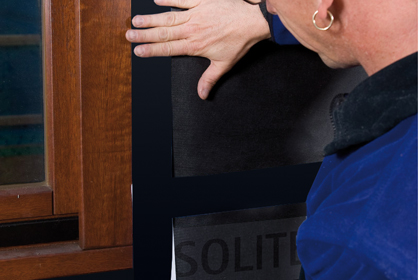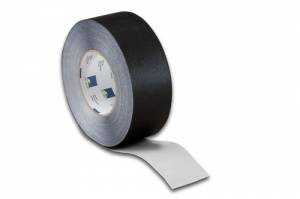Tape Tescon INVIS
Available in all stores
Conditionnement
en rouleau
Unité de vente
rouleau
TESCON INVIS
Black multi-purpose adhesive tapeAdvantages
- All-round adhesive tape for internal and external use, 6 months of outdoor exposure
- Easy to tear off by hand with a soft fleece backing
- Suitable for sealing to penetrations
- Can be plastered over
- Also used for windtight adhesion of wall lining membranes behind suspended façades
- Waterproof adhesive
Application
Exterior use: Creation of a windproof seal for wall lining membranes using pro clima SOLITEX FRONTA WA and SOLITEX FRONTA QUATTRO and for underlay and sarking membranes. Windproof bonding of wood-based panels for underlays. Airtight bonding of on-roof and refurbishment vapour retarders and airtight membranes.
Interior use: Airtight bonding of vapour retarders and airtight membranes and of airtight wood-based panels.
All bonding can be carried out between these products as well as to smooth adjacent non-mineral components (z. B. pipe feed-throughs, skylights) for both interior and exterior use.
Technical specs
| Material | |
| Backing | special PP fleece |
| Adhesive | waterproof SOLID adhesive |
| Release film | siliconized paper |
| Attribute | Norm | Value |
| Colour | black | |
| Exposure time | 6 months | |
| Application temperature | above -10 °C / 14 °F | |
| Temperature resistance | permanent -40 °C/-40 °F to +90 °C/194 °F | |
| Storage | cool and dry |
Substrate
Before sticking, subsurfaces should be brushed off, wiped clean with a cloth or cleaned using compressed air.
Adhesion to frozen surfaces is not possible. There must be no water-repellent substances (e.g. grease or silicone) on materials to be bonded. Subsurfaces must be sufficiently dry and have sufficient load-bearing capacity.
Permanent adhesion is achieved on all pro clima interior and exterior membranes, other vapour retarder and airtight membranes (e.g. those made of PE, PA, PP and aluminium) as well as other underlay/sarking and wall lining membranes (e.g. those made of PP and PET).
Adhesion and joints can be carried out on planed and painted wood, hard plastics and metal (e.g. pipes, windows etc.), hard wood-based panels (chipboard, OSB and plywood panels, MDF board and softwood fibre sub-roof panels).
Wood fibre sub-roof panels and smooth mineral subsurfaces require pre-treatment with TESCON PRIMER RP before bonding. Concrete or plaster subsurfaces must not be sandy or crumbling.
The best results in terms of structural stability are achieved on high-quality subsurfaces.
It is your responsibility to check the suitability of the subsurface; adhesion tests are recommended in certain cases.
Pretreatment with TESCON PRIMER RP is recommended in the case of subsurfaces with insufficient load-bearing capacity.
Limiting factors
The bonds should not be subjected to tensile strain.
After sticking membranes made of foil or paper, the weight of the insulating material must be supported by lathing. The adhesive tape should be supported by battens if necessary.
Press firmly to secure the adhesive tape. Ensure there is sufficient back-pressure.
Windproof, airtight or rainproof seals can only be achieved on vapour retarding membranes, roof lining membranes or façade membranes that have been laid without folds or creases.
Ventilate regularly to prevent build-up of excessive humidity and use a dryer if necessary.
Applications
Intérieur et extérieur. Collage étanche à l’air et au vent de freins-vapeurs, membranes d’étanchéité, écrans de sous-toiture et panneaux de dérivés du bois, ainsi que les raccords sur métal, plastiques rigides, profilés de fenêtres, supports minéraux lisses (béton, pré-murs, briques de construction rapide, .. ).
Supports adéquats : Un collage durable et étanche est possible sur toutes les membranes pro clima pour usage interne ou externe et les films PE-, PA-, PP-, et aluminium. Collages et raccords sont également possibles sur bois raboté ou verni, plastiques ou métaux rigides (par ex tuyaux, fenêtres...), panneaux de dérivés de bois rigides (OSB, agglomérés, multiplex, MDF, panneaux de fibres de bois et de sous-toitures), supports minéraux lisses ( béton, pré-murs, plafonnages). Le collage sur panneaux de sous-toitures en fibres de bois ou sur des supports minéraux lisses nécessite le traitement préalable avec la sous-couche TESCON PRIMER RP ou AC. Avant le collage, il convient de nettoyer les supports à l’aide d’une brosse ou de les essuyer avec un chiffon. Le collage sur supports recouverts d’une fine couche de glace n’est pas possible. Les matériaux à coller ne peuvent pas être recouverts de substances anti-adhésives (par ex graisses ou silicone). Ils doivent être suffisamment solides.
Points forts
- Couleur noire, invisible sur membranes noires
- Très souple et légèrement élastique
- Grande thermostabilité
- Exposition aux intempéries possible pendant 6 mois
